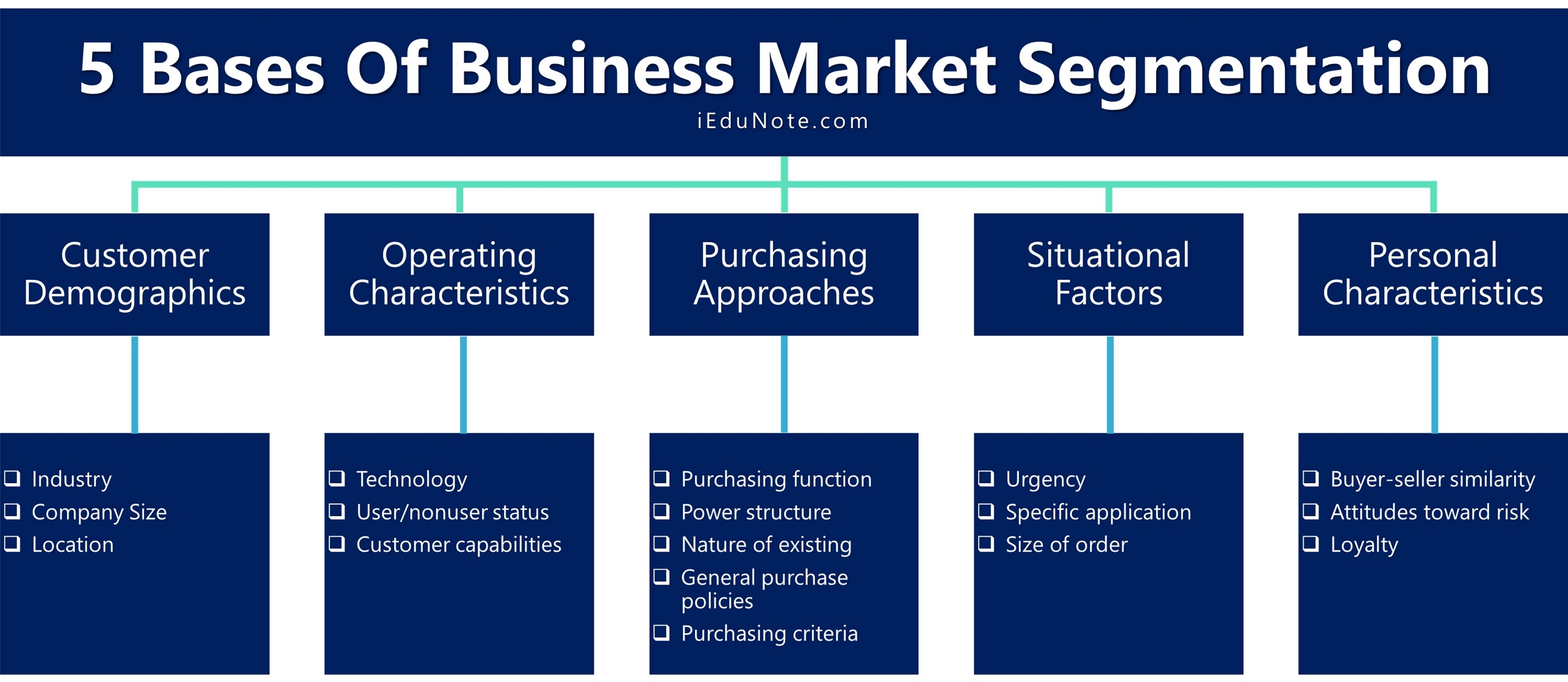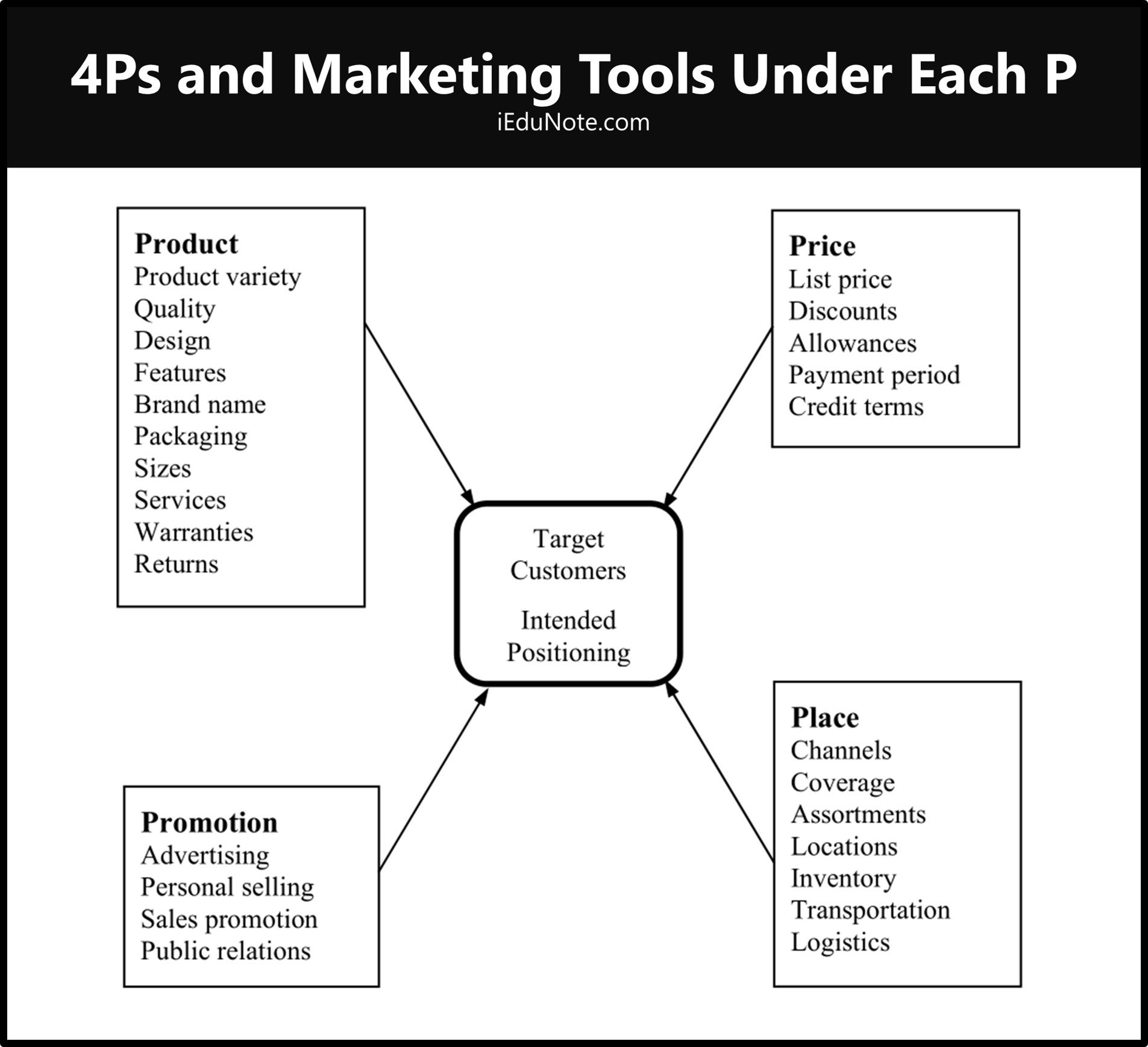Business markets need to be segmented like consumer markets geographically or by benefits sought, user status, usage rate, and loyalty status. Some additional variables are also used for segmenting business markets.
These are Business Market Segmentation bases;
- Customer demographics (industry, company size),
- operating characteristics,
- purchasing approaches,
- situational factors, and
- personal characteristics.
The table below examples various criteria for the bases for business market segmentation.

| 5 Bases of Business Market Segmentation | |
| Demographics | |
| Industry | What geographical areas should we focus on? |
| Company Size | What size companies should we focus on? |
| Location | Which industries that buy this product should we focus on? |
| Operating Characteristics | |
| Technology | What customer technologies should we focus on? |
| User/nonuser status | Should we focus on heavy, medium, or light users or nonusers? |
| Customer capabilities | Should we focus on customers needing many services or few services? |
| Purchasing Approaches | |
| Purchasing function | Should we focus on companies with highly centralized or decentralized purchasing organizations? |
| Power structure | Should we focus on companies that are engineering dominated, financially dominated, or marketing dominated? |
| Nature of existing | Should we focus on companies with which we already have strong relationships or go after the most desirable companies? |
| General purchase policies | Should we focus on companies that prefer leasing? Service contracts? Systems purchases? Sealed biding? |
| Purchasing criteria | Should we focus on companies that are seeking quality? Service? Price? |
| Situational Factors | |
| Urgency | Should we focus on companies that need quick delivery or service? |
| Specific application | Should we focus on certain applications of our product rather than all applications? |
| Size of order | Should we focus on large or small orders? |
| Personal Characteristics | |
| Buyer-seller similarity | Should we focus on companies whose people and values are similar to ours? |
| Attitudes toward risk | Should we focus on risk-taking or risk-avoiding customers? |
| Loyalty | Should we focus on companies that show high loyalty to their suppliers? |
Business marketers must first determine which customers they want to serve.
By deciding to operate in segments instead of serving the whole market, companies will be able to deliver value to consumers at maximum profits. Thus, Goodyear and other tire companies should decide which industries they want to serve.
Manufacturers buying tires vary in their needs. Markets of luxury and high-performance cars want higher-grade tires than makers of economy models. And the tires needed by aircraft manufacturers must meet much higher safety standards than tires needed by farm tractor manufacturers.
Having chosen a particular industry, a company may go for further segmentation by customer size or geographic location. The company might establish separate systems for handling larger or multiple-location customers.
For example, Steelcase, a major producer of office furniture, first segments customers into ten industries, including banking, insurance, and electronics.
Next, the company salespeople work with independent Steelcase dealers to handle smaller, local, or regional Steelcase customers in each segment.
But many national, multiple-location customers, such as Exxon or IBM, have special needs that may reach beyond the scope of individual dealers.
So, Steelcase uses national accounts managers to help its dealer networks handle its national accounts.
Given the target industry and customer size can also be segmented by purchase approaches and criteria—for example, government, university, and industrial laboratories by scientific instruments.
But they differ in their purchase criteria. Government labs want low prices and service contracts as they have fund constraints to buy instruments but have the money to maintain them.
University labs want equipment that requires little regular service because they don’t have their service people. Industrial labs need highly reliable equipment because they can not afford an interruption in their production process.
Many marketers are convinced that buying behavior and benefits provide the best basis for segmenting business markets as they do in case of consumer segmentation.
For example, a recent study of the customers of Signode Corporation’s industrial packaging division revealed the following four segments, each seeking a different mix of price and service benefits :
- Programmed Buyers: The buyers view Signode’s products as not very important to their operations. They buy the products as a routine purchase, usually pay full price, and accept below-average service. This is a highly profitable segment for Signode.
- Relationship Buyers: These buyers regard Signode’s packaging products as moderately important and are knowledgeable about competitors’ offerings. They prefer to buy from Signode as long as its price is reasonably competitive. They receive a small discount and a modest amount of service. This segment is Signode’s second most profitable.
- Transaction Buyers: These buyers see Signode’s products as very important to their operations. They are price and service sensitive. They receive about a 10 percent discount and above average service. They are knowledgeable about competitors’ offerings and ready to switch for a better price, even if it means losing some service.
- Bargain Hunters: These buyers see Signode’s products as very important and demand the deepest discount and the highest service. They know the alternative suppliers’ bargain hard and are ready to switch at the slightest dissatisfaction. Signode needs these buyers for volume purposes, but they are not very profitable.
This segmentation scheme has helped Signode to do a better job of designing marketing strategies that take into account each segment’s unique retains to varying levels of price and service.

